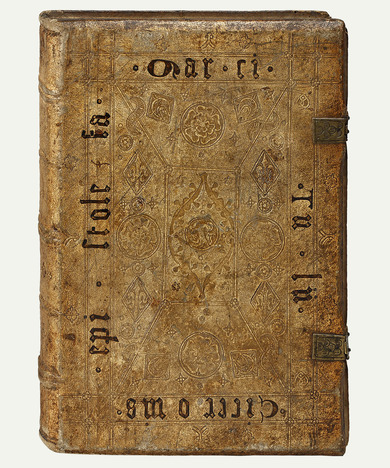Gothic book-binding by Johannes Richenbach
Gothic book-binding by Johannes Richenbach
Clothes make the man, covers make the books.
Edwin Redslob, 1930
The book binding, made of light-coloured leather with a delicate blind-stamped decoration, was done by the hand of Johannes Richenbach (died 1486), a prominent bookbinder of the 15th century. Stamps of roses and lilies, as well as of the image of Christ and the Agnus Dei decorate the front cover. The book's title has been impressed in the textura typeface and runs around the outside margin. Richenbach, who was in fact chaplain of the parish church of Geislingen in Ulm, in addition to performing his clerical duties devoted himself with a passion to bookbinding. He made use of the newly invented printing press and used movable type to sign his works and give them a title imprint. In some cases the name of the customer is also imprinted. A unique feature of his work is that he emphasized individual letters or stamped designs using different colours. Richenbach is one of the first bookbinders in Germany who experimented with roller handstamps as decorative tools.
For a long time, leather was one of the main materials used for binding books. The earliest bindings, found in monasteries of the Copts, the ancient Christians in Egypt, were usually simple covers made of wood or papyrus wrapped in goat or sheep leather, occasionally already decorated or dyed. Since late antiquity various decorative techniques such as blind stamping, tooling or hallmarking arose, which were refined during the Middle Ages. The invention of printing in the 15th century made it possible to produce books in larger print runs, which led to an increasing demand for book bindings. Until then, it was common to work with single stamps or chisels, now bookbinders began to experiment with stamping plates or rollers, chiefly in order to facilitate the production of large numbers of bindings for commercial purposes.

